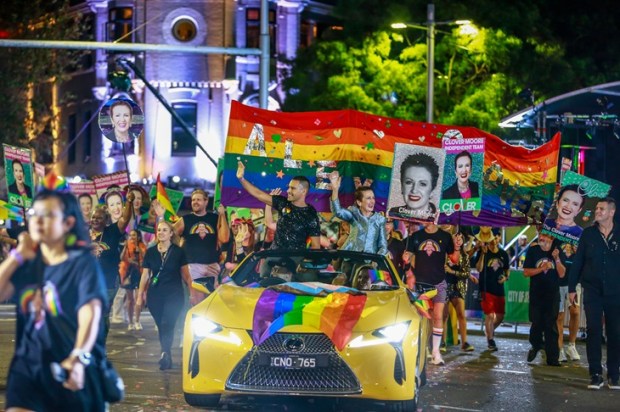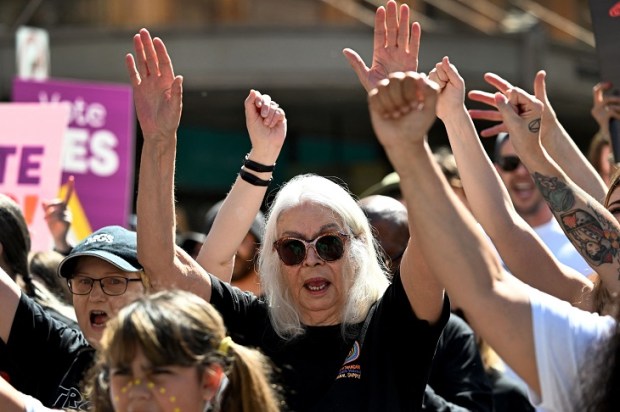If you had recently awoken from a decade-long coma and jumped online you’d think you were still in a dreamscape. You’d find a world where a major American retailer promoted pro-trans kidswear, the country’s biggest beer brand used a trans woman to advertise to cowboys, and two of the world’s biggest sports brands dressed biological men in women’s sportswear.
As a creative director in advertising with 20 years of experience, I’m well aware of the penchant for marketers to fall victim to the latest fashion or fad.
The most alluring of those right now is ‘trans’.
What could be edgier than a trans woman selling Bud Light to the rust belt? Well, that’d be Nike putting a trans woman in women’s sportwear. Edgier still? A trans woman in an Adidas bikini. Even edgier? Target’s line of LGBTQ2+ children’s wear.
There’s the possibility that the marketing motivation was one-upmanship of sorts: to be the coolest kid and do what fashion has always done – raise a middle finger to social norms. And it’s very possible that given the echo chambers we’re in, the same folk thought that people might actually embrace this.
Elite marketing teams are based in big, typically liberal cities which themselves are intellectual bubbles. Add to this, many marketers are ‘work from homers’, living lives online with algorithm-biased social media feeding back existing belief systems.
We’re encouraged to offer our pronouns on Linkedin and that anyone who identifies as a woman is immediately that. When you live a blinkered existence, it’s possible you believe everyone else thinks the same as you: that trans women are facing ‘genocide’ and trans kids’ lives are ‘in danger’.
We’re on steady diets of sameness, living lonely atomised lives while looking for meaning. So why not be on ‘the right side of history’ and produce a campaign that represents the most ‘marginalised’ whilst being uber fashionable?
Well, because if you’re in marketing and you actually want to build your brand, evidence that ‘virtue signalling’ to your demographic doesn’t work is abundantly clear. Gillette’s infamous decision to berate its core demographic by buying into the lie that masculinity was the exact equivalent to toxicity through a campaign that asked, ‘Is this the best a man can get?’ proceeded to lose the company $8 billion.
Surely the Bud Light VP behind celebrating influencer Dylan Mulvaney’s 365th day ‘as a woman’ had an incling it wouldn’t work…? While backs were patted in the marketing boardroom, in households eyes were rolling. Bud Light’s parent company Anheuser-Busch lost $27 billion off its share price with sales down nearly 30 per cent compared to 2022. Several of those behind the marketing fail have stepped down.
When Nike chose the same ambassador to model women’s wear, they should have known it wasn’t a good idea. In the immediate aftermath, Nike felt the hit and suffered a $4 billion loss.
Then followed Adidas, who chose a trans swimsuit in part of their ‘Let Love Be Your Legacy’ collection made by South African designer Rich Mnisi to celebrate Pride Month. They might have wondered what would happen next: thousands of social posts now include the hashtag #AdidasHatesWomen from unhappy customers.
When Target released LGBTQIA2S+ clothing for kids, including pink tie-dye shirts for toddlers that read ‘trans rights are human rights’, they had to suspect it just might backfire. Within two weeks, Target lost $15 billion in 10 days, from a company worth $60 billion. ‘Boycott Target’ became the Number 1 song on iTunes knocking off Taylor Swift.
So what’s going on? How could this ‘echo chamber’ possibly reverberate so intensely that marketing teams would voluntarily pursue a strategy that carries the risk of imploding their brand value?
One answer is that a kind of Woke mind virus has infected the cultural elite of the Western world and it hasn’t just fallen from the sky. ‘Woke’, or more accurately ‘Critical Social Justice’, has its roots in several ideologies that have metastasised over centuries.
To go right back, much of this stems from the Enlightenment where the idea of being a free individual and all that entailed was the highest good in the liberal world. Fast forward 500 years, that thinking has now entered a trajectory of freeing yourself from everything, even reality.
Critical Social Justice has sitting beneath it a set of several extremely dangerous ideas that have been fermenting in the darkness within academia. After the death of George Floyd, these ideas roared out from universities into HR departments and powered through all major institutions at the highest levels.
Amongst these divisive ideologies are Postmodernism that states that there’s no such thing as objective truth, that ‘lived experience’ is trusted over evidence … feelings over facts. Neo-Marxism divides society into different victim groups based on an individual’s race, gender, and sexuality. Intersectionalism pits these oppressed classes against one another in a struggle to be the most victimised. Then there’s the various Critical Theories that function to strip away all norms. Most relevant here is Queer Theory that openly attacks the idea of heterosexuality which is part of the ‘privileged’ class who define norms, so queer theorists seek to redefine and own this cultural property.
And the reason why so many kind hearted-people fall for all this is because it dolls itself up in pretty words like ‘social justice’ and ‘diversity, inclusivity, and equity’.
We now take it as read that gender self-identification is a human right and that drag storytime for children must be completely normal.
Perhaps that’s why, in the wake of furore surrounding Mulvaney, in a pinned comment to Nike’s verified Instagram account, the company instructed customers to, ‘Be kind, be inclusive… Encourage each other.’
But do they believe it? Or did these marketers, as per our second scenario, know they’d torpedo their own brands, because they knew they had to?
See, there’s another deeply cynical reason marketing teams pursue a pro LGBTQ+ agenda and you’ve probably already heard of it: ESG, which stands for Environmental, Social, and Governance.
The ESG concept was created at the United Nations in 2003 by James Gifford with the premise that companies who are environmentally and socially responsible with good governing practices have the highest likelihood of having a solid long-term rate of return.
The ESG rating system is hugely influential because it’s been adopted by ESG rating entities, essentially gigantic financial institutions like banks, governments in the questionable ‘public-private partnership’ model, and most importantly index fund managers, amongst them are BlackRock, Vanguard, and State Street. Fund managers like these control $40 trillion in investment, often holding the largest shares of many Fortune 500 companies, which means they have enormous clout.
But the system requires measurement, which makes it corruptible, and since its inception, ESG has been co-opted by Critical Social Justice types. So ‘E’ now means Net Zero, ‘S’ means gender ideology, and ‘G’ requires you to hire DEI officers and politically sympathetic board members to ensure the political ideology is being enforced.
Powerful activist groups within these institutions have adopted ESG as a way to push their Diversity, Equity, and Inclusion agenda. That’s done through different outsourced metrics like the Corporate Equality Index (CEI) which was an initiative of the Human Rights Group established in 2002.
Major financial institutions use CEI as proxy metrics to determine an ESG score and how a corporation is behaving with regard to required activism. They work in tandem as somewhat of a social credit system for corporations. The 100-point CEI score measures companies on ostensibly laudable initiatives like ‘Workforce Protections’. But amongst the five key criteria are ‘Corporate Social Responsibility’ for ‘marketing or advertising to LGBTQ+ customers’.
The HRC sends representatives to corporations every year, telling them exactly what they need to make visible and if they don’t follow through investor funds start putting pressure on the boards, activists are mobilised and, insidiously, any company that does business with them will also be penalised. Almost 900 companies have a perfect score of 100.
Corporations are required to proactively promote the ideology through the carrot/stick model where CEI points are awarded for trans ‘visibility’ but taken away if they don’t comply.
And the reason companies care more about their ESG score than their customers, the survival of the brand or a fiduciary responsibility to shareholders is two-fold. All businesses have two constant pressures on them: one is to ensure long-term revenue, and the other is the huge capital outlays that require ongoing financing. A poor ESG score can determine access to the line of credit; its termination can lead to a liquidity crisis and ultimately insolvency. ESG rating agencies use scoring metrics like the CEI as a crucial measurement to determine who gets financing and capital. Added to that, if you don’t receive an adequate score you’ll be kicked out of a fund which knocks your stock down because fewer people are investing in it.
In the wake of the controversy, Bud Light cans sold for 14 cents and it lost the Number 1 brand position. How has Bud Light responded? By doubling-down and pledging to support LGBTQ+ business owners of colour, and sponsoring a pride parade.
Despite this, the Human Rights Campaign down listed Anheuser-Busch’s CEI score for not sufficiently standing with Dylan Mulvaney by bowing to the consumer boycott.
Companies are now beholden to a system. They are trapped by a cartel where it’s lose-lose: appease the ESG mob and you’ll lose customers. Apologise to customers and you’ll get whacked by a stick. Please the pagans and you’ll anger the Woke gods.
When Target CEO said selling their LBGTQ-friendly merchandise was ‘the right thing for society’ we must ponder again whether he actually believes it, but far more importantly, is he right?
Because here we’re met with a core issue of woke morality infesting capitalism: that companies are now telling us what’s right and wrong.
Is it ‘right’ to be promoting pro-trans clothing to children? Because there has been significant global pushback about the very idea of ‘Trans Kids’.
The Cass Report into the catastrophic failure of the Tavistock clinic in the UK revealed that many of kids reporting gender dysphoria have multiple comorbidities like anxiety, depression, and eating disorders, with a least a third being autistic. One key finding was that gender confusion results as a by-product of those issues and is not the cause.
A 2021 study of detransitioners found that 70 per cent ‘realised that my gender dysphoria was related to other issues’.
But the horrible irony is that we already knew this. Pioneering and extensive work in the eighties Kenneth Zucker revealed that 80 per cent of kids will overcome their feelings of gender confusion if left alone, with most of those kids growing up to be gay.
In many cases, after just one visit, puberty blockers are prescribed to pre-pubescent teens having irreversible consequences often resulting in sterility and permanent loss of sexual functioning.
The National Association of Practicing Psychiatrists (NAPP) here in Australia, in their guide encourages a cautious approach as do Finland, Sweden, and France as research over 40 years ago confirmed puberty is the resolution to gender dysphoric feelings not the cause.
Add all this to the very real possibility that the massive increase in trans-identifying youth is a social contagion referred to as ‘Rapid Onset Gender Dysphonia’, coined by well-known physician and researcher Lisa Littman.
Knowing we know all this, and now hearing the horrific stories of detransitioners, the question must be asked, are we doing the right thing promoting the idea of trans kids?
It’s not the Emperor that has no clothes. The Emperor is now the Empress, and not only does she have clothes, but they’re fabulous, and she’s stunning and brave. Submitting to this is the cost of doing business.
These ‘faux beliefs’ are a kind of career crampon that allows those that submit to get a foothold into the next level, without which you’re a bigot, ostracised, and left dangling on the corporate cliff. So here we see the primal driving forces are fear and reward.
Regardless of authenticity, it doesn’t change the potential damage these ideas are doing. But it does raise the possibility that cynical, corporate greed is allowing ideologically driven activists with deeply questionable motives to set the moral agenda for everyone.
And ‘everyone’, being the vast majority of people, believe that: a woman doesn’t have a penis; that allowing gender-identifying males into women’s spaces might open the doors to opportunistic sexual predators; that it seems odd for drag queens to want to read sexualised books to children; that male rapists should not be in female prisons; and that if a trans woman was a woman then why is she a trans woman and not just a woman?
We are living through a mass delusion that we need to wake up from.

























